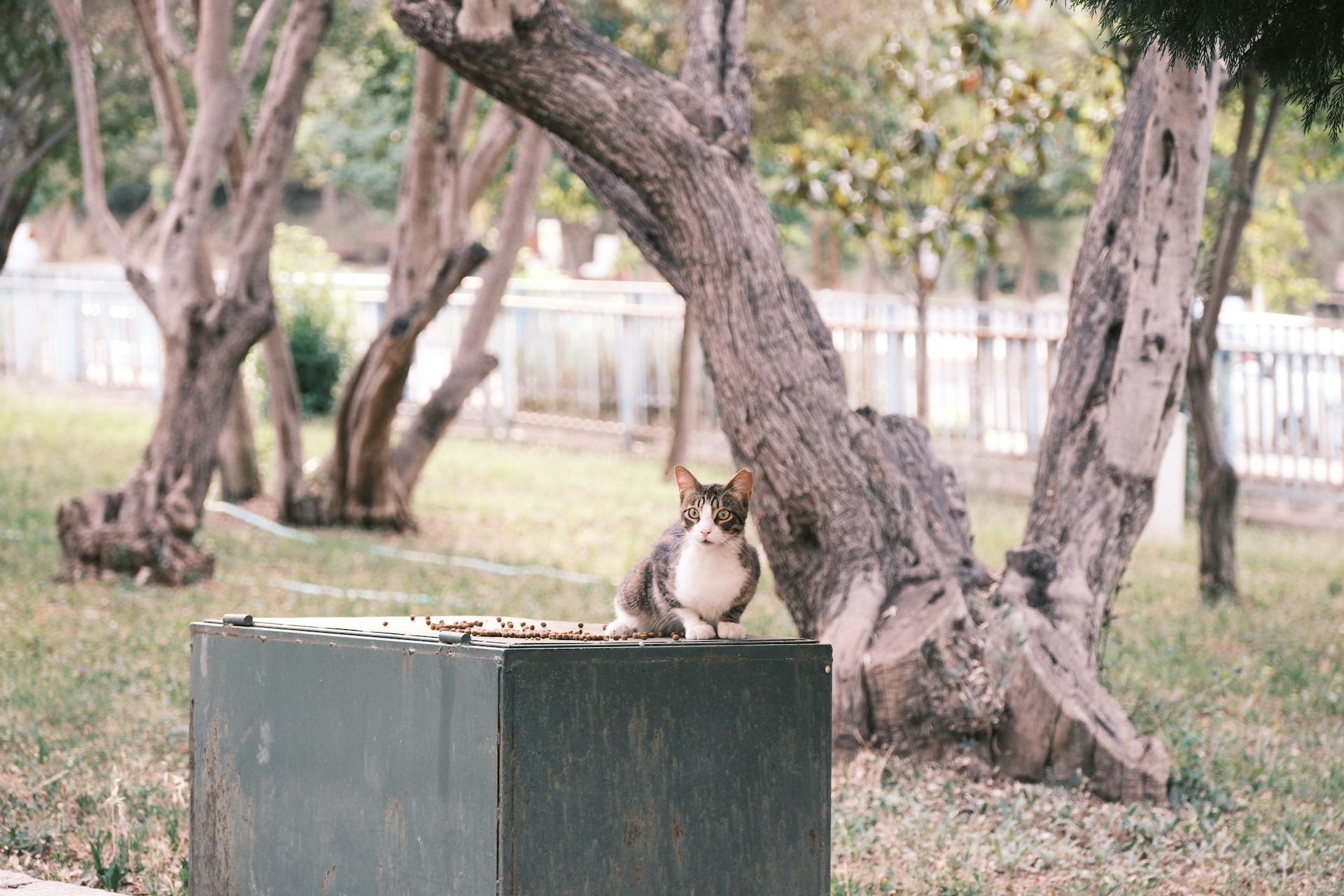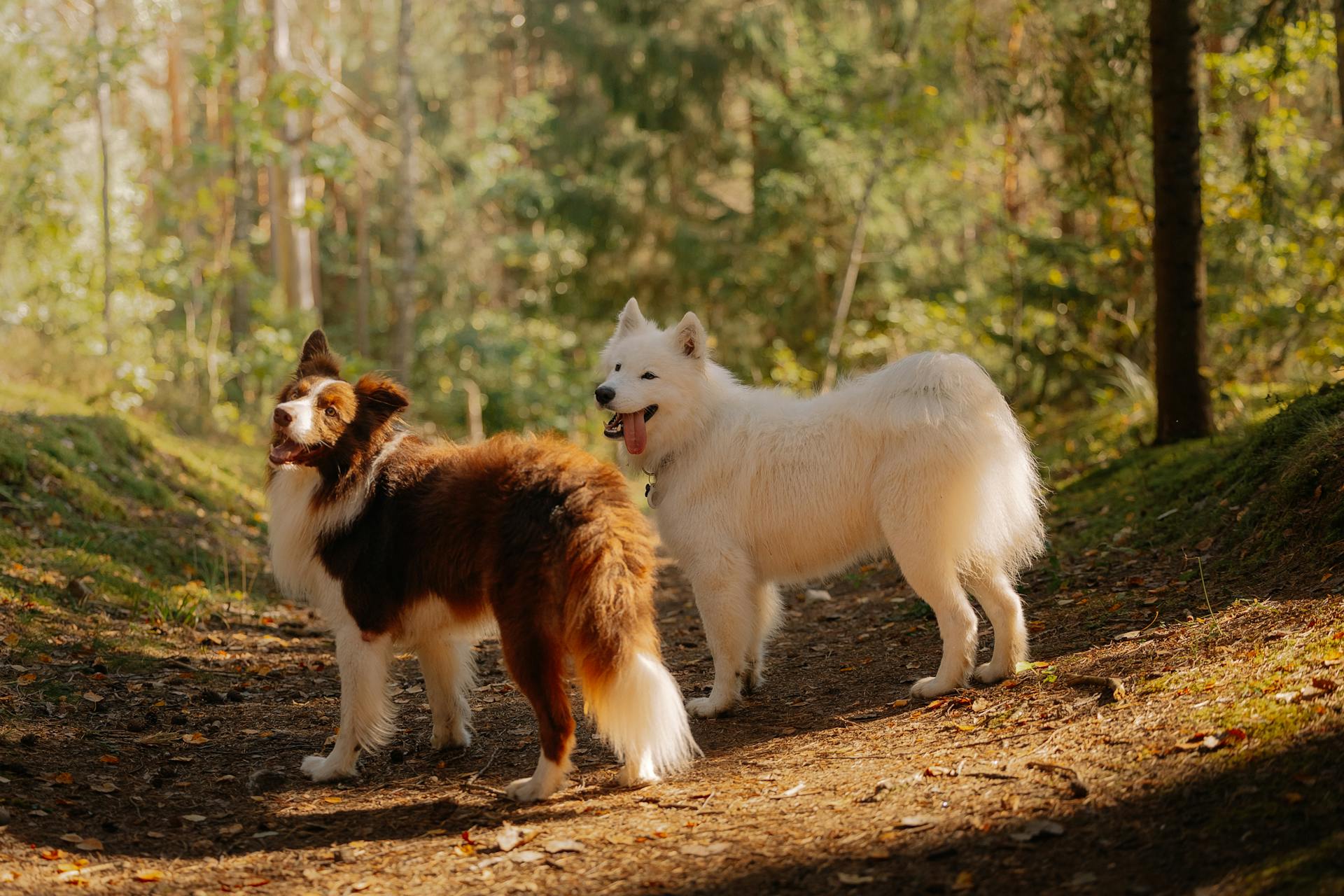
Catching stray dogs requires a gentle and humane approach.
Start by observing the dog's behavior and body language to determine if it's friendly or fearful. If the dog appears friendly, slowly and calmly approach it, speaking in a soothing voice to reassure it.
Before attempting to catch the dog, make sure you have a suitable enclosure or carrier to safely transport it.
How to Catch
Catching a stray dog can be a delicate process, and it's essential to approach it with care. Entice the stray dog with food, such as hotdogs or bits of pizza, by filling an empty, crinkly bag with treats and loudly crinkling it to get the dog's attention.
If the dog comes to you willingly, try to safely catch it and check for ID. If you find a number, call the owner if you can. Otherwise, take it to a veterinary clinic in case it has a microchip with owner info.
A dog catch pole is a humane way to catch a stray dog, but only use it if your own safety won't be at risk. Before trying to catch the dog, set up a crate nearby to place the dog in after catching it.
Here are the steps to catch a stray dog safely:
Some dogs may be insecure, timid, reactive, or undersocialized, making them difficult to catch. In these cases, it's essential to know what will spook them, what will soothe them, and what precise move to make to catch them safely.
Humane Trapping
To catch a stray dog, you'll want to use a humane trap. These traps come in various shapes, sizes, and configurations, and can be purchased at a store that sells hunting equipment or rented/borrowed from your local animal shelter or animal control center.
It's essential to place the trap in a good location, where the stray dog frequently visits and feels comfortable approaching. Ideally, this spot should be where you can monitor the trap without trespassing on personal property or being obtrusive.
To make the trap inviting, cover it with blankets to help the stray dog feel safer when entering it. You can also add several layers of blankets on the bottom floor of the trap for increased comfort.
Here's a quick checklist to ensure your trap is set up correctly:
Remember, if you see the stray dog in the trap, contact your veterinarian, local animal shelter, or animal control center for further instruction and assistance.
Don't Talk
Dogs in a state of panic can associate auditory signals with frightening experiences.
This is because adrenaline can make them very reactive and prone to making associations with things.
Calling out to a lost dog or slapping your leg encouragingly can actually make things worse.
Dogs in fight or flight mode will likely panic and bolt, even if it's their owner making the overtures.
The first person to encounter a lost dog may unwittingly create a negative association that will haunt the dog for a long time.
This is because the dog is not processing information, but simply reacting to its surroundings.
A patient and gentle approach is usually the best way to interact with a lost dog.
This can help the dog feel more at ease and increase the chances of a successful reunion.
Setting a Humane Trap
You can use a humane trap to catch a stray dog, and it's actually quite straightforward. Obtain a trap from a store that sells hunting equipment, or consider renting or borrowing one from your local animal shelter or animal control center.
The trap should be placed in an area where the stray dog frequently visits, and ideally, it should be in a spot where the dog feels comfortable approaching without feeling threatened. It's also essential to place the trap where you can monitor it without trespassing on personal property or being obtrusive.
To make the trap inviting to the stray dog, cover it with blankets to help him feel safer when he steps inside. You can also add several layers of blankets on the bottom floor of the trap for increased comfort.
Before leaving the trap for the stray dog, test it to ensure it closes properly. You can do this by applying pressure to the trap mechanism with your hands, or if you have a dog similar in size to the stray, have him walk into the trap.
Here are the basic steps to follow when setting a humane trap:
Remember to check the trap the day after you've set it up for the stray dog, and if you see him in it, contact your veterinarian, a local animal shelter, or your local animal control center for further instruction.
Training and Leashing
When putting a leash on a stray dog, it's essential to be gentle and patient. If the dog is not interested in food or treats, try petting them while holding the leash and gradually slipping it on.
Dogs don't like being petted on the top of their head, so it's best to avoid this area. They may tolerate head petting from loved ones, but it's not recommended from unfamiliar people.
You can use a loop leash, like a lasso, as a temporary tool to keep you and the dog safe. Make the biggest diameter head opening you can and offer food in the center to lure the dog forward.
Don't Grab
Grabbing a loose dog can be a recipe for disaster. Bonnie Folz from New York shares a cautionary tale about a woman who got badly bitten in the ear while trying to rescue a pit bull.
Don't make sudden moves, as this can trigger a dog's fear response and lead to biting. If you lunge, dogs may bite because they're afraid, says Bonnie Folz.
It's better to use a more gentle and calculated approach. Opening your car door and trying to entice the dog to jump in can be a safer option.
A vehicle can be used as a "trap" of sorts until help can be summoned. This method allows you to safely contain the dog without putting yourself at risk.
Leash Training
Dogs don't like being petted on the top of their head, just like humans don't, so it's best to avoid this area.
To put a leash on a stray dog, you may need to use a loop leash, which is perfect for keeping both you and the dog safe.
If the dog is not interested in food or treats, try gently petting them while slipping a leash on.
Pet the dog softly and subtly while putting on the leash to avoid alarming them.
Make a big diameter head opening in the leash to lure the dog forward and put their head through it easily.
You can use string, rope, or any substitute as a temporary tool for putting a leash on a stray dog.
Assume a rescued dog's health and behavior is the worst and hope for the best, taking every caution possible.
It's essential to take it slow and gentle when putting a leash on a stray dog to avoid any injuries or pain.
Rescue and Case Studies
Stray dogs can be rescued using a humane trap or a snare pole, as seen in the case of a stray dog in a rural area that was trapped using a humane trap with food bait.
The key to a successful rescue is to approach the dog calmly and slowly, allowing it to become accustomed to your presence.
In some cases, stray dogs may be trapped in tight spaces, such as storm drains or abandoned buildings, and require specialized equipment, like a ladder or a camera, to safely rescue them.
Discover more: Puppy Mill Dogs for Adoption
Rescuing a Case Study
Rescuing a case study is a delicate process that requires attention to detail and a clear understanding of the situation.
The first step in rescuing a case study is to assess the current state of the project, which can be done by reviewing the existing data and identifying the key issues.
A good starting point is to analyze the root cause of the problems, which in many cases can be attributed to a lack of clear objectives or inadequate resource allocation.
By redefining the project's scope and objectives, it's possible to refocus the team's efforts and make the project more manageable.
For instance, in the article section "Common Challenges in Rescue and Case Studies", it was mentioned that 75% of rescue projects fail due to scope creep.
This highlights the importance of establishing clear boundaries and prioritizing tasks to avoid scope creep.
In the section "Best Practices for Rescue and Case Studies", it was noted that a well-defined project plan can help mitigate risks and ensure a successful outcome.
By developing a comprehensive project plan, teams can identify potential roadblocks and develop contingency plans to overcome them.
Here's an interesting read: South Korean Dog Meat Farm Rescue
Lost Belonging
Time is of the essence when a pet goes missing. Canines can cover a lot of ground in a day, leaving them miles away from where they were separated from their humans.
The risk of a "Good Samaritan" picking up a lost dog and transporting them who-knows-where is very real. It's essential to raise awareness about your lost pet as soon as possible.
Notifying neighbors, local shelters, and veterinary clinics can help generate leads and sightings. This should be done immediately after a pet goes missing.
A lost dog can be miles away from where they were separated from their humans in just a day. This emphasizes the importance of acting quickly to raise awareness about your missing pet.
You might enjoy: Black Dog Syndrome Awareness Month
Frequently Asked Questions
How do I attract a scared stray dog?
To attract a scared stray dog, use super yummy and fragrant treats or engage in play with a ball or frisbee while ignoring the dog until it approaches you.
Sources
- https://www.petplace.com/article/dogs/pet-care/dog-care/how-to-catch-stray-dogs-so-you-can-take-them-to-a-shelter
- https://www.wikihow.com/Catch-a-Stray-Dog
- https://www.whole-dog-journal.com/lifestyle/how-to-catch-a-dog-on-the-loose/
- http://www.wildlifeanimalcontrol.com/straydogcatch.html
- https://www.funpawcare.com/2013/03/06/how-to-capture-a-stray-dog/
Featured Images: pexels.com


